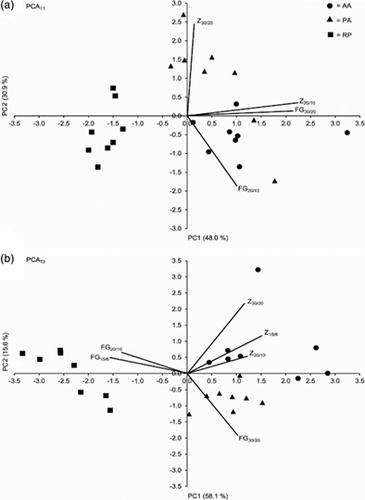当前位置:
X-MOL 学术
›
Plant Species Biol.
›
论文详情
Our official English website, www.x-mol.net, welcomes your
feedback! (Note: you will need to create a separate account there.)
Seed germination traits of Ailanthus altissima, Phytolacca americana and Robinia pseudoacacia in response to different thermal and light requirements
Plant Species Biology ( IF 1.1 ) Pub Date : 2020-08-03 , DOI: 10.1111/1442-1984.12286 Maria Pepe 1 , Loretta Gratani 1 , Giuseppe Fabrini 1 , Laura Varone 1
Plant Species Biology ( IF 1.1 ) Pub Date : 2020-08-03 , DOI: 10.1111/1442-1984.12286 Maria Pepe 1 , Loretta Gratani 1 , Giuseppe Fabrini 1 , Laura Varone 1
Affiliation

|
Invasion of alien plant species (IAS) represents a serious environmental problem, particularly in Europe, where it mainly pertains to urban areas. Seed germination traits contribute to clarification of invasion dynamics. The objective of this research was to analyze how different light conditions (i.e., 12‐hr light/12‐hr darkness and continuous darkness) and temperature regimes (i.e., 15/6°C, 20/10°C and 30/20°C) trigger seed germination of Ailanthus altissima (AA), Phytolacca americana (PA) and Robinia pseudoacacia (RP). The relationship between seed germination and seed morphometric traits was also analyzed. Our findings highlight that temperature rather than light was the main environmental factor affecting germination. RP germinated at all tested temperatures, whereas at 15/6°C seeds of AA and PA showed physiological dormancy. RP had a higher germination capacity at a lower temperature, unlike AA and PA, which performed better at the highest temperatures. Light had a minor role in seed germination of the three species. Light promoted germination only for seeds of PA, and final germination percentage was 1.5‐fold higher in light than in continuous darkness. Seed morphometric traits (thickness [T], area [A] and volume [V]) had a significant role in explaining germination trait variations. The results highlight the importance of increasing our knowledge on seed germination requirements to predict future invasiveness trends. The increase in global temperature could further advantage AA and PA in terms of germinated seeds, as well as RP by enhancing the germination velocity, therefore compensating for a lower germination percentage of this species at the highest temperatures.
中文翻译:

不同温度和光照条件下臭椿,美洲扁桃和刺槐种子的萌发特性
外来植物物种(IAS)的入侵是一个严重的环境问题,尤其是在欧洲,那里主要涉及城市地区。种子发芽特性有助于澄清入侵动态。这项研究的目的是分析不同的光照条件(即12小时光照/ 12小时黑暗和连续黑暗)和温度状态(即15/6°C,20/10°C和30/20°)如何变化C)触发臭椿(AA),美洲疫霉(PA)和刺槐的种子萌发(RP)。还分析了种子萌发与种子形态特征之间的关系。我们的发现表明,温度而不是光是影响发芽的主要环境因素。RP在所有测试温度下均发芽,而在15/6°C下,AA和PA的种子表现出生理休眠。RP在较低的温度下具有较高的发芽能力,这与AA和PA在最高温度下的表现更好有关。光在这三个物种的种子发芽中只占很小的地位。光仅能促进PA种子发芽,光下的最终发芽率比连续黑暗中高1.5倍。种子形态特征(厚度[T],面积[A]和体积[V])在解释发芽性状变异中具有重要作用。结果突出了增加我们对种子萌发要求的知识以预测未来入侵趋势的重要性。全球温度的升高可以通过提高发芽速度进一步提高AA和PA的发芽种子以及RP的优势,因此可以补偿在最高温度下该物种较低的发芽率。
更新日期:2020-10-07
中文翻译:

不同温度和光照条件下臭椿,美洲扁桃和刺槐种子的萌发特性
外来植物物种(IAS)的入侵是一个严重的环境问题,尤其是在欧洲,那里主要涉及城市地区。种子发芽特性有助于澄清入侵动态。这项研究的目的是分析不同的光照条件(即12小时光照/ 12小时黑暗和连续黑暗)和温度状态(即15/6°C,20/10°C和30/20°)如何变化C)触发臭椿(AA),美洲疫霉(PA)和刺槐的种子萌发(RP)。还分析了种子萌发与种子形态特征之间的关系。我们的发现表明,温度而不是光是影响发芽的主要环境因素。RP在所有测试温度下均发芽,而在15/6°C下,AA和PA的种子表现出生理休眠。RP在较低的温度下具有较高的发芽能力,这与AA和PA在最高温度下的表现更好有关。光在这三个物种的种子发芽中只占很小的地位。光仅能促进PA种子发芽,光下的最终发芽率比连续黑暗中高1.5倍。种子形态特征(厚度[T],面积[A]和体积[V])在解释发芽性状变异中具有重要作用。结果突出了增加我们对种子萌发要求的知识以预测未来入侵趋势的重要性。全球温度的升高可以通过提高发芽速度进一步提高AA和PA的发芽种子以及RP的优势,因此可以补偿在最高温度下该物种较低的发芽率。







































 京公网安备 11010802027423号
京公网安备 11010802027423号